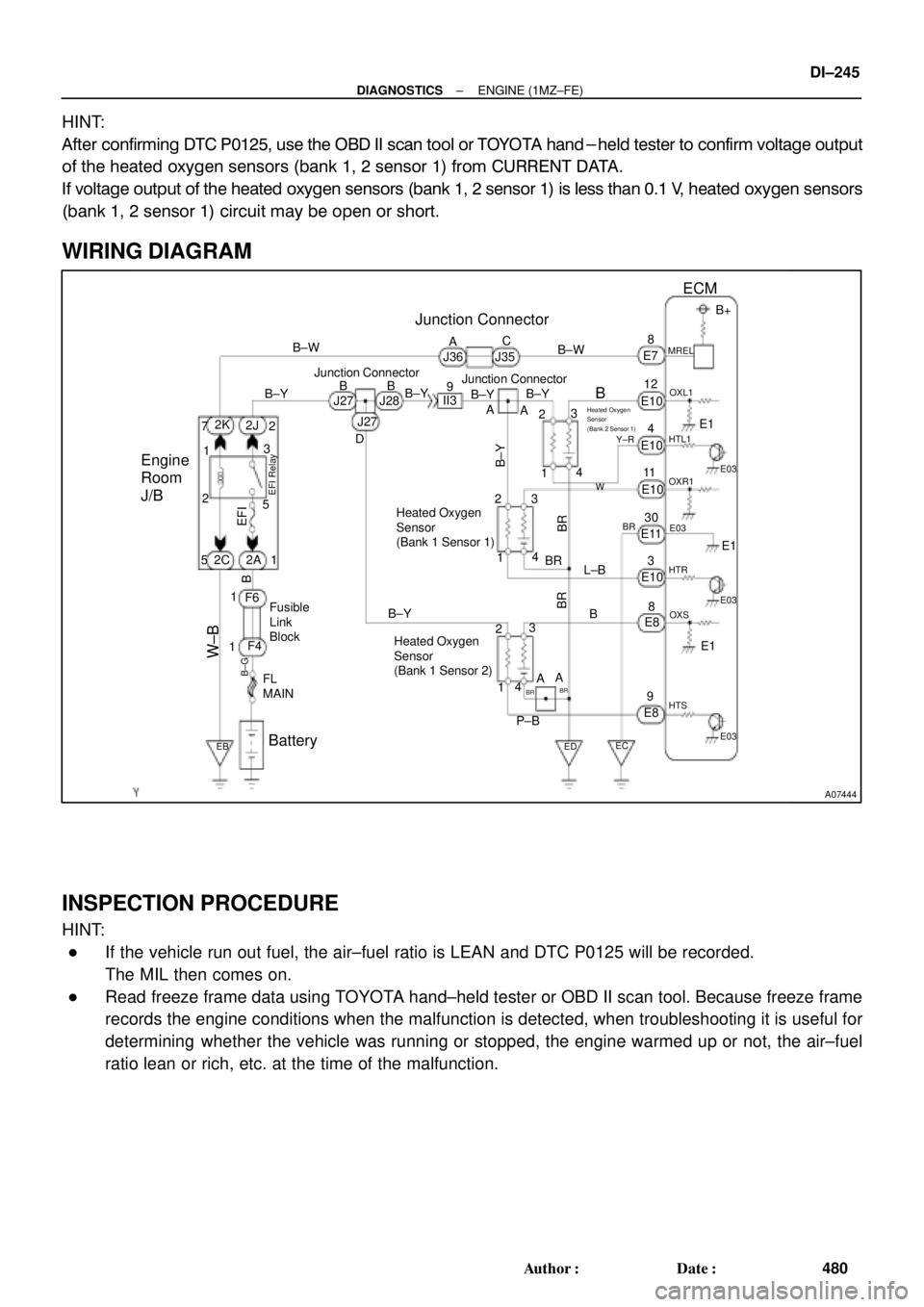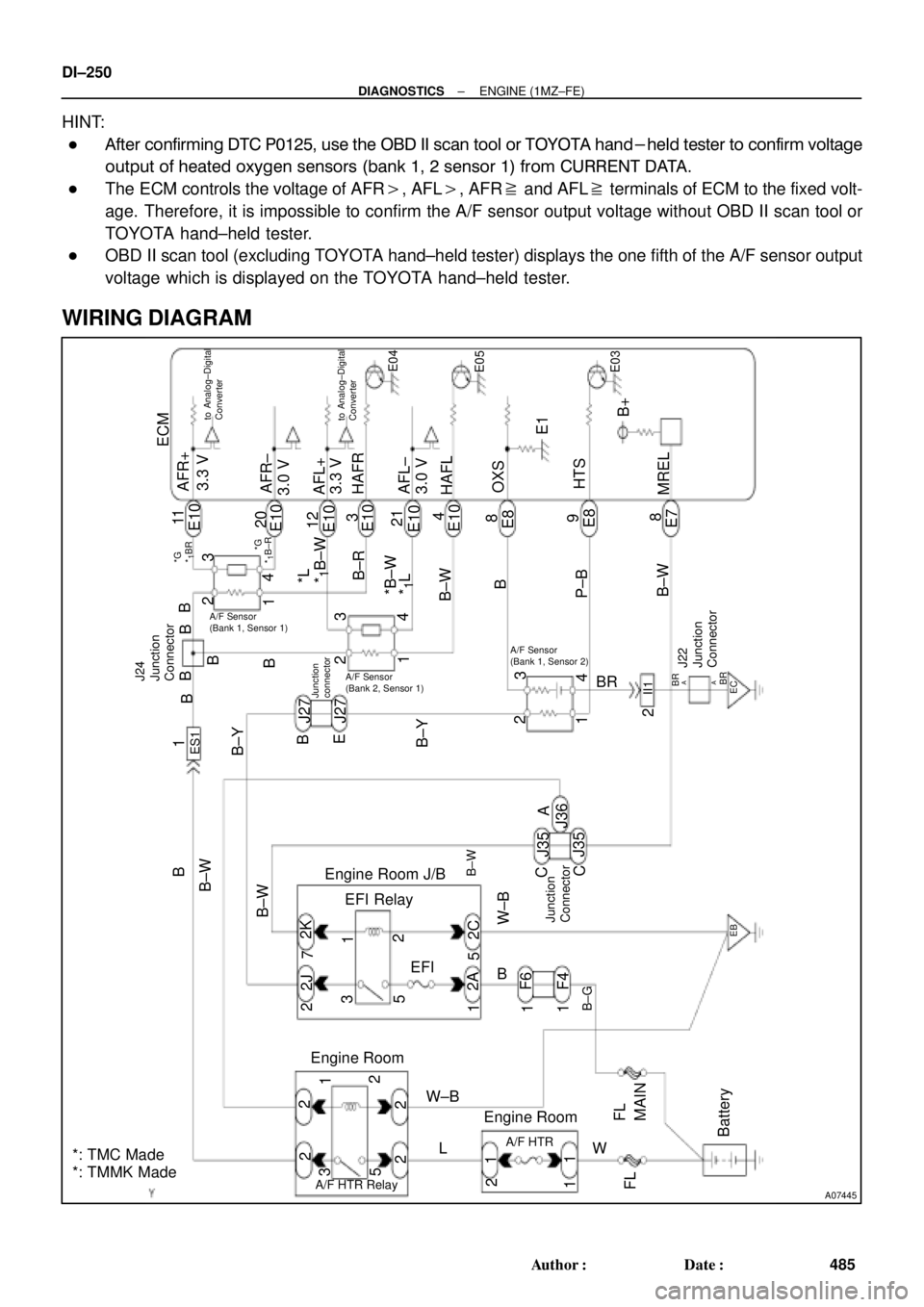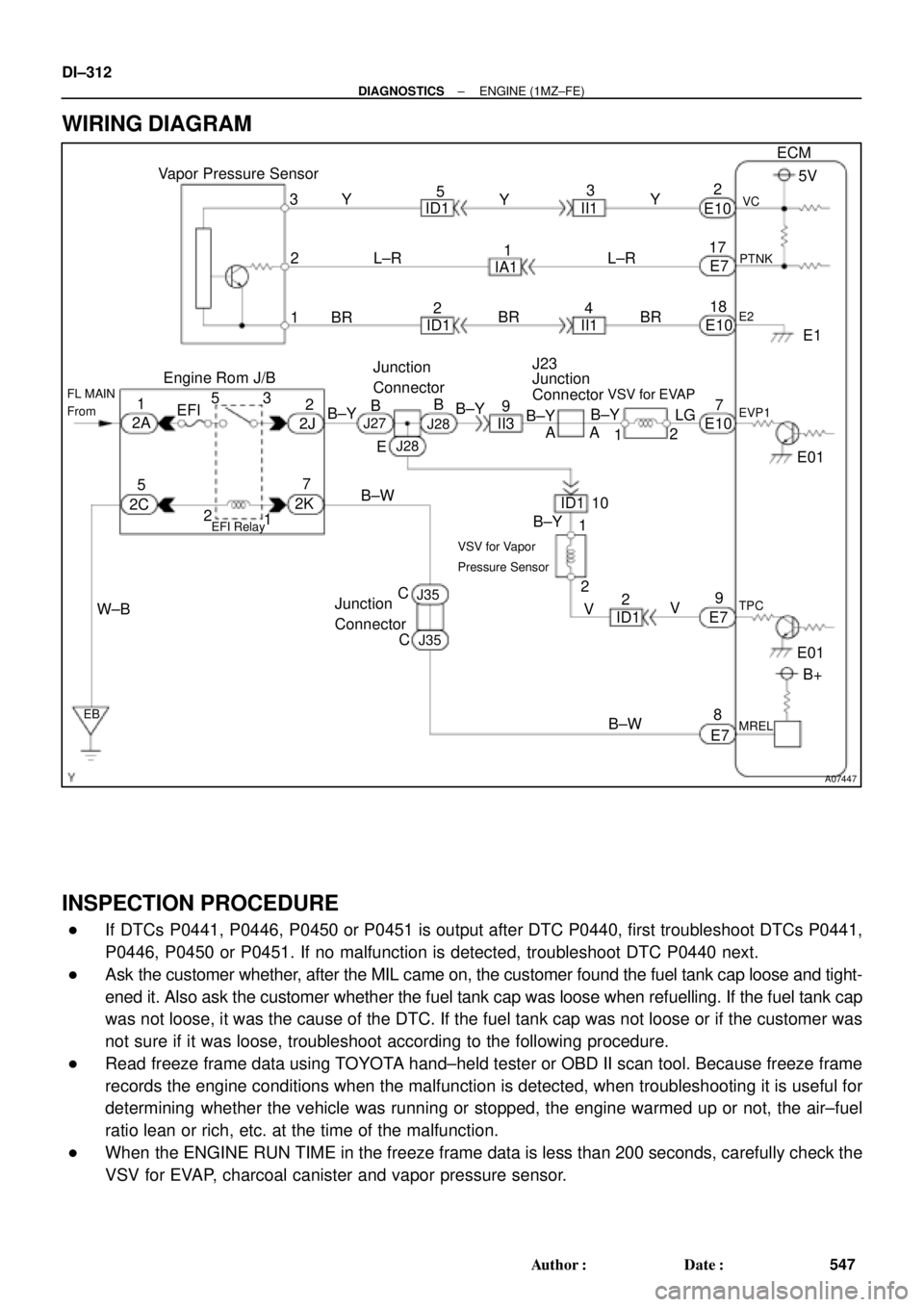Page 2641 of 4770

DI07E±06
± DIAGNOSTICSENGINE (1MZ±FE)
DI±221
456 Author�: Date�:
PROBLEM SYMPTOMS TABLE
SymptomSuspect AreaSee page
Engine does not crank (Does not start)1. Starter
2. Starter relayST±18
ST±20
No initial combustion (Does not start)
1. ECM power source circuit
2. Fuel pump control circuit
3. Engine control module (ECM)DI±369
DI±374
IN±31
No complete combustion (Does not start)1. Fuel pump control circuitDI±374
Engine cranks normally (Difficult to start)
1. Starter signal circuit
2. Fuel pump control circuit
3. CompressionDI±384
DI±374
EM±3
Cold engine (Difficult to start)1. Starter signal circuit
2. Fuel pump control circuitDI±384
DI±374
Hot engine (Difficult to start)1. Starter signal circuit
2. Fuel pump control circuitDI±384
DI±374
High engine idle speed (Poor idling)1. A/C signal circuit (Compressor Circuit)
2. ECM power source circuitAC±88
DI±369
Low engine idle speed (Poor idling)1. A/C signal circuit (Compressor Circuit)
2. Fuel pump control circuitAC±88
DI±374
Rough idling (Poor idling)1. Compression
2. Fuel pump control circuitEM±3
DI±374
Hunting (Poor idling)1. ECM power source circuit
2. Fuel pump control circuitDI±369
DI±374
Hesitation/Poor acceleration (Poor driveability)1. Fuel pump control circuit
2. A/T faultyDI±374
DI±453
Surging (Poor driveability)1. Fuel pump control circuitDI±374
Soon after starting (Engine stall)1. Fuel pump control circuitDI±374
During A/C operation (Engine stall)1. A/C signal circuit (Compressor Circuit)
2. Engine control module (ECM)AC±88
IN±31
Unable to refuel/Difficult to refuel1. ORVR systemEC±6
Page 2643 of 4770
A06156
Engine Room J/B
EFI Relay
Junction
Connector
J20
Junction
Connector EFI
2A
2K2J
2C B
EB
7 1
2
5
13
2
F9
F4
11
B±G
Mass Air
Flow Meter
B±Y
B±Y
B±Y
R
R±BECM
E2GVG
E2 P 5B
B
9
4 A A
5
3
8
W±B
E10 B±W
E7 10
19
MRELB+ E10 Junction
ConnectorJ35 J36
A
A
B±W
Fusible
Link
Block
FL
MAIN
Battery
J27J28
II3
± DIAGNOSTICSENGINE (1MZ±FE)
DI±223
458 Author�: Date�:
WIRING DIAGRAM
INSPECTION PROCEDURE
HINT:
Read freeze frame data using TOYOTA hand±held tester or OBD II scan tool. Because freeze frame records
the engine conditions when the malfunction is detected, when troubleshooting it is useful for determining
whether the vehicle was running or stopped, the engine warmed up or not, the air±fuel ratio lean or rich, etc.
at the time of the malfunction.
Page 2644 of 4770
A00436
ON
4 (+)
BE6653
S05337
DI±224
± DIAGNOSTICSENGINE (1MZ±FE)
459 Author�: Date�:
1 Connect OBD II scan tool or TOYOTA hand±held tester, and read value of mass
air flow rate.
PREPARATION:
(a) Connect the OBD II scan tool or TOYOTA hand±held tester to the DLC3.
(b) Turn the ignition switch ON and push the OBD II scan tool or TOYOTA hand±held tester main switch
ON.
(c) Start the engine.
CHECK:
Read mass air flow rate on the OBD II scan tool or TOYOTA hand±held tester.
RESULT:
Type IType II
Mass air flow rate (gm/sec.)0.0271.0 or more
Type I Go to step 2.
Type II Go to step 5.
2 Check voltage of mass air flow meter power source.
PREPARATION:
(a) Disconnect the mass air flow meter connector.
(b) Turn the ignition switch ON.
CHECK:
Measure voltage between terminal 4 of mass air flow meter con-
nector and body ground.
OK:
Voltage: 9 ~ 14 V
NG Check for open in harness and connector
between EFI main relay (Marking: EFI) and
mass air flow meter (See page IN±31).
OK
Page 2665 of 4770

A07444
BatteryJunction Connector
MREL
ECM
B
B+
E1
E03
E03
E1E1
E03 OXL1
HTL1
OXR1
HTR
OXS
HTS
E8E8 E10 E11E7
E10
E10
E108
12
4
11
30
3
8
9
Y±R
3
2
4
1
W
BR
L±B
B
BR
3 2
4
1
B±Y
B±Y
B±Y
A A B Junction Connector
B
J28 J27
J27 B±YJunction Connector
2K
2J
3
1
2
5
EFI
2C 2A 1 5
F6
F4 1
1
B
W±B
EB
FL
MAINFusible
Link
Block
E03
Engine
Room
J/B
B±G
Heated Oxygen
Sensor
(Bank 1 Sensor 2)3
2
1
EDEC
P±BA
A
BR
BR4 B±YHeated Oxygen
Sensor
(Bank 1 Sensor 1)II3 B±WAC
J36 J35B±W
EFI Relay
BR
BR
2 7B±Y9
Heated Oxygen
Sensor
(Bank 2 Sensor 1)
D
± DIAGNOSTICSENGINE (1MZ±FE)
DI±245
480 Author�: Date�:
HINT:
After confirming DTC P0125, use the OBD II scan tool or TOYOTA hand-held tester to confirm voltage output
of the heated oxygen sensors (bank 1, 2 sensor 1) from CURRENT DATA.
If voltage output of the heated oxygen sensors (bank 1, 2 sensor 1) is less than 0.1 V, heated oxygen sensors
(bank 1, 2 sensor 1) circuit may be open or short.
WIRING DIAGRAM
INSPECTION PROCEDURE
HINT:
�If the vehicle run out fuel, the air±fuel ratio is LEAN and DTC P0125 will be recorded.
The MIL then comes on.
�Read freeze frame data using TOYOTA hand±held tester or OBD II scan tool. Because freeze frame
records the engine conditions when the malfunction is detected, when troubleshooting it is useful for
determining whether the vehicle was running or stopped, the engine warmed up or not, the air±fuel
ratio lean or rich, etc. at the time of the malfunction.
Page 2670 of 4770

A07445
B
BB B
2 142
31 23
4
BR
23
1
B±W P±BB B±WB±R
*
1L
E8 E8 E10 E10
E78 9 84 213 122011
AFR+
AFR±
AFL+
AFL± HAFR
OXS
HTS
MREL HAFLECM
3.3 V
3.3 V 3.0 V
3.0 V
E1
B+ E10 E10E10E10 1
J27
Engine Room J/B
F6
F4 2J
2A
2C2K
2
7
5 1
EFI Relay
1
1B
B±W
B±W
B EFI
1 2
2
52
22 3
L W±B1
1 2
A/F HTR
1
W
FL
MAIN FLEngine RoomBattery*
1B±W B
B
B±G
1
2 3
5
E04
E05
E03
*1B±R *1BR *G
*G
*B±W*L
ES1
J27 B
E
Junction
connector
A/F Sensor
(Bank 2, Sensor 1)
B±Y
A/F Sensor
(Bank 1, Sensor 2)
BRII1A
ABR
J22
Junction
Connector J24
Junction
Connector
B±Y
W±B
B±W
J35
J35J36A C
C
EB EC
A/F Sensor
(Bank 1, Sensor 1)
Engine Room
A/F HTR Relay
*: TMC Made
*: TMMK Made
Junction
Connector
4
to Analog±Digital
Converter
to Analog±Digital
Converter
DI±250
± DIAGNOSTICSENGINE (1MZ±FE)
485 Author�: Date�:
HINT:
�After confirming DTC P0125, use the OBD II scan tool or TOYOTA hand-held tester to confirm voltage
output of heated oxygen sensors (bank 1, 2 sensor 1) from CURRENT DATA.
�The ECM controls the voltage of AFR�, AFL�, AFR� and AFL� terminals of ECM to the fixed volt-
age. Therefore, it is impossible to confirm the A/F sensor output voltage without OBD II scan tool or
TOYOTA hand±held tester.
�OBD II scan tool (excluding TOYOTA hand±held tester) displays the one fifth of the A/F sensor output
voltage which is displayed on the TOYOTA hand±held tester.
WIRING DIAGRAM
Page 2684 of 4770
A02023
ON
HTL (+) HTR (+) HTS (+)
DI±264
± DIAGNOSTICSENGINE (1MZ±FE)
499 Author�: Date�:
1 Check voltage between terminals HTR, HTS, HTL of ECM connectors and body
ground.
PREPARATION:
(a) Remove the glove compartment (See page SF±73).
(b) Turn the ignition switch ON.
CHECK:
Measure voltage between terminals HTR, HTS, HTL of the
ECM connectors and body ground.
HINT:
�Connect terminal HTR to bank 1 sensor 1.
�Connect terminal HTS to bank 1 sensor 2.
�Connect terminal HTL to bank 2 sensor 1.
OK:
Voltage: 9 ~ 14 V
OK Check and replace ECM (See page IN±31).
NG
2 Check resistance of heated oxygen sensor heater (See page SF±71).
NG Replace heated oxygen sensor.
OK
Check and repair harness or connector between EFI main relay (Marking: EFI) and heated oxygen
sensor, and heated oxygen sensor and ECM (See page IN±31).
Page 2713 of 4770
A07446
J20
Junction
Connector
EFI Relay
2K2J
2C
BB±YJ27 J28
W±B
EB
9B±Y Y±G
AA1218
13 1
2
G±Y
BRECM
EGR
E01
EGLS5 V
E2 32
VC
5 V
THG
E7
2
1W±GY
BR18
8
MREL
B+ BR
EGR Gas Temp. Sensor
E10 E10
22
E11 E10E11
Engine Room J/B
2A2
7 1
53
1 5
EFI
VSV
for EGR
B±Y
Junction
Connector
B
2
B±Y
J35
J35C
C Junction
ConnectorB±W
B±W
B±W
EGR Valve
Position Sensor
II3From
FL MAIN
S06906
Vehicle Speed
70 ~ 90 km/h
(43 ~ 56 mph)
Idling
IG SW OFF(1)(2)(3)
(4)(5)
Warmed up 3 ~ 5 min. 3 min. 3 ~ 5 min. 2 min.Time
± DIAGNOSTICSENGINE (1MZ±FE)
DI±293
528 Author�: Date�:
WIRING DIAGRAM
SYSTEM CHECK DRIVING PATTERN
Page 2732 of 4770

A07447
Vapor Pressure Sensor
2J2
9J23
B±Y
V
VSV for EVAP
LG
AA
2
1ECM
5V
VC
PTNK
E1
E2
EVP1
E01
E01
TPC
3
2
Engine Rom J/B
MREL VSV for Vapor
Pressure Sensor
II3
EB
B±W
W±BL±R Y
1BRE10
E7
E10
E72
17
18
7
9
E78
EFI Relay
IA1 L±RY Y
ID1 II13
5
1
II1 BR
BR
ID1 E10
B±Y
J28 J27
B
ID1 10
1
2
ID12 2A
7 1
2C5
2K 53
2
1 EFI
B±WFL MAIN
From
24
B+
J28E B±YB
B±Y
B±Y
V
J35
J35C
C Junction
Connector
Junction
ConnectorJunction
Connector DI±312
± DIAGNOSTICSENGINE (1MZ±FE)
547 Author�: Date�:
WIRING DIAGRAM
INSPECTION PROCEDURE
�If DTCs P0441, P0446, P0450 or P0451 is output after DTC P0440, first troubleshoot DTCs P0441,
P0446, P0450 or P0451. If no malfunction is detected, troubleshoot DTC P0440 next.
�Ask the customer whether, after the MIL came on, the customer found the fuel tank cap loose and tight-
ened it. Also ask the customer whether the fuel tank cap was loose when refuelling. If the fuel tank cap
was not loose, it was the cause of the DTC. If the fuel tank cap was not loose or if the customer was
not sure if it was loose, troubleshoot according to the following procedure.
�Read freeze frame data using TOYOTA hand±held tester or OBD II scan tool. Because freeze frame
records the engine conditions when the malfunction is detected, when troubleshooting it is useful for
determining whether the vehicle was running or stopped, the engine warmed up or not, the air±fuel
ratio lean or rich, etc. at the time of the malfunction.
�When the ENGINE RUN TIME in the freeze frame data is less than 200 seconds, carefully check the
VSV for EVAP, charcoal canister and vapor pressure sensor.